PRODUCTS
Pests and diseases control in different growth periods of corn
Pests and diseases control in different growth periods of corn
1. Period of emergence
There is basically no disease during this period, but in order to ensure the normal growth of corn, the main measures are as follows:

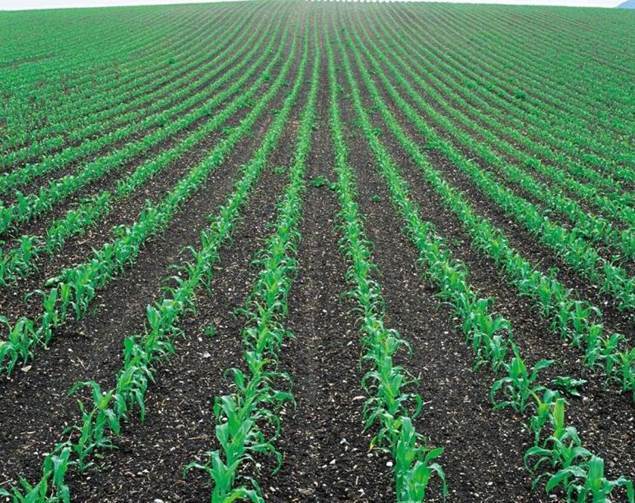
1.1 Timely thinning and fixing seedlings. Seedlings should be thinning at three-leaf stage and fixing at four-leaf stage, and strong seedlings with consistent growth should be selected. In the plot with severe seedling shortage, double plants with consistent growth can be kept to ensure the density.
1.2 Cultivation and weeding. After the corn emerges, it is necessary to plow the soil in time, and sprayed with high lipid membrane and loose soil to prevent the infection of germs, protect the seedlings from growing vigorously, weeding and promote deep rooting.
1.3 Topdressing and watering. After fixing seedlings and before jointing, topdressing should be fertilized according to plant protection requirements and sprayed with nitrogen, phosphorus, and potassium foliar fertilizers, which have the effect of strengthening seedlings and promote the growth of leaves and stalks, laying a solid foundation for large spikes. The number of watering at the seedling stage can be controlled at 1 to 2 times. In case of waterlogging in the seedling stage, ditching and cultivating should be timely.
1.4 Pest control. The main pests at seedling stage are armyworm and thrips. Emamectin benzoate, acetamiprid and imidacloprid can control armyworm and prevent the recurrence of virus diseases. In addition, pay attention to the occurrence of underground pests, lambda-cyhalothrin can be sprayed before sowing or after emergence for comprehensive control.
2. Ear period
2.1 Northern Corn Leaf Blight
Symptoms
It mainly damages the leaves of corn, and also damages the sheath and bract leaves in severe cases. Symptoms usually appear first on the lower leaves. Leaf lesions are long (5 to 10 cm) and elliptical, gray-green at first but then turn pale gray or tan. Under moist conditions, dark gray spores are produced, usually on the lower leaf surface, which give lesions a "dirty" gray appearance.
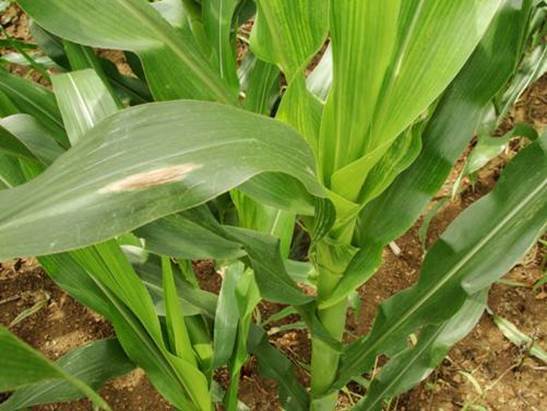
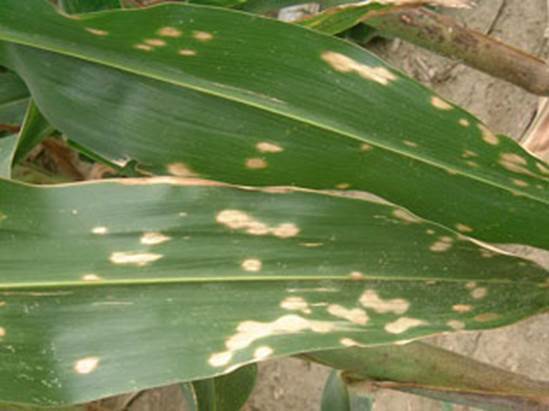
Disease cycle
The fungus overwintering on residual diseased plants (mycelia or conidia), which is the primary infection source in the second year. The appropriate temperature of onset is 20-28℃. When the conditions are suitable, the pathogen will multiply rapidly and produce a large number of conidia, which will be transmitted by wind. Except for the variety, the epidemic degree of this disease is mainly determined by environmental conditions (rain, humidity), and it is usually prone to disease under the condition of high temperature and humidity.
Control
(1) Select disease-resistant varieties; (2) Rational close planting and increasing application of organic fertilizer, phosphorus and potassium fertilizer; (3) In the early stage of the disease, use carbendazim 50% 500 times or thiophanate methyl 80% 800-1000 times solution, 50-75 kg liquid per mu, spray once every 7-10 days for a total of 2 to 3 times. In case of serious occurrence, azoxystrobin 32.5% 3000 times can be speared for control.
2.2 Southern corn leaf blight
Symptoms
It can occur from seedling stage to late stage. The lower leaves first appeared brown translucent water-stain-like spots, which gradually spread upwards, most when heading. The enlarged lesions are yellowish-brown spindle or oval, often with russet halos on the edges. When the disease is severe in the later stage, the leaves die. When the humidity is high, black fluffy matter appears on the lesions.
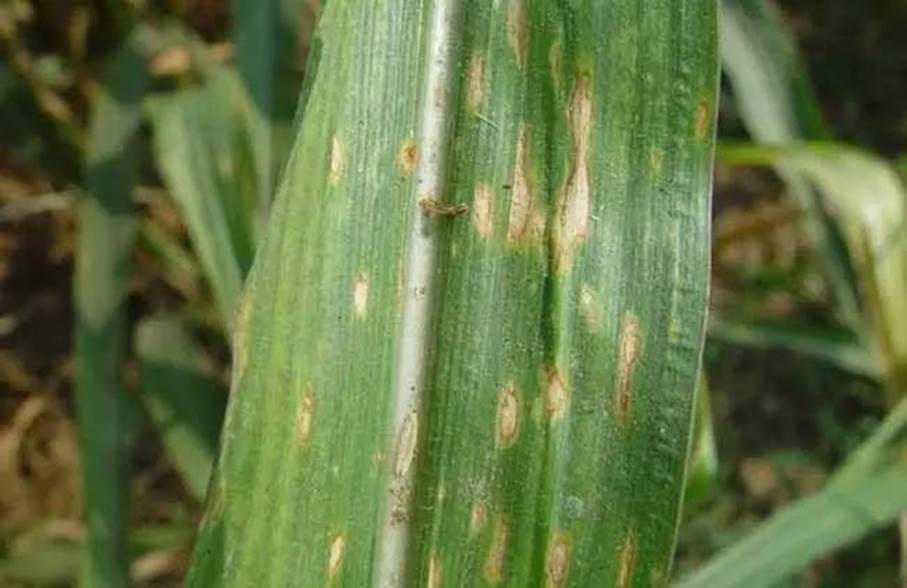
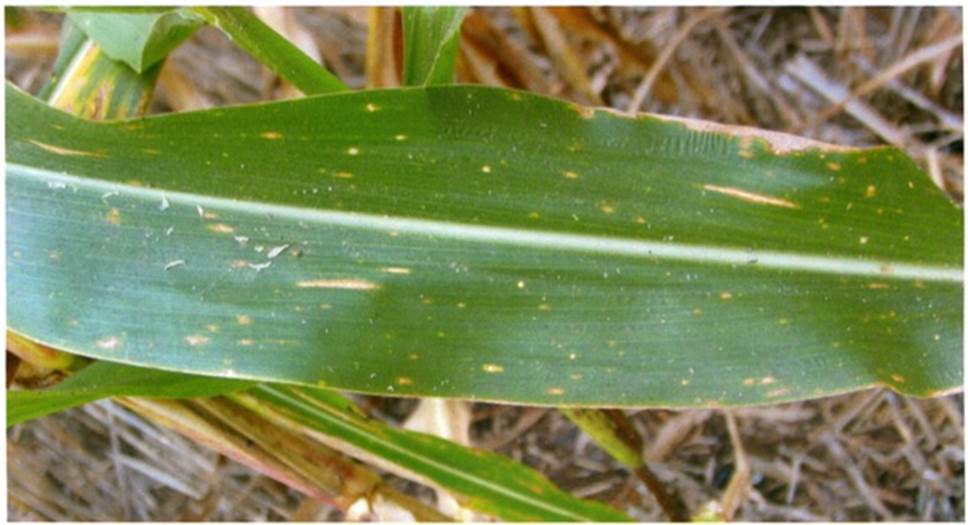
Disease cycle
The fungus mainly overwinters in corn residue, and conidia can also overwinter, but the survival rate is low. The optimum temperature for mycelium development is 28-30℃, and the optimum temperature for spore germination is 26-32℃. With monthly average temperature above 25℃ and rainy weather, the disease is easy to spread. Continuous cropping of corn, poor soil fertility, too late sowing, is also prone to disease.
Control
(1) Crop rotation, deep plowing of the soil after autumn, deep burying of diseased bodies, and sterilization sources. Treat straw as early as possible before sowing.
(2) Strengthen cultivation management. Applying organic fertilizer, topdressing nitrogen fertilizer at ear stage, and strengthening field management such as intertillage and drainage to enhance plant disease resistance.
(3) Chemical control.500 times solution of carbendazim 50% or thiophanate methyl 70% WP or 800 times solution of mancozeb 90%, with 50-75 kg per mu, sprayed once every 7-10 days, for 2-3 times in total. It is basically consistent with the control of Northern Corn Leaf Blight.
2.3 Corn Sheath Blight
Symptoms
An important fungal disease which leads to withering of the entire plant body if occurring severely. The lesion becomes cloud-shaped, ash white with brown border. Brown sclerotia with a smooth surface are produced on the lesion at the latter stage of the occurrence. They drop to ground, and become the primary inocula of next year. It occurs severely under high temperature (especially 30C or more) and high humidity condition and the lesion progresses by 1cm or more a day.
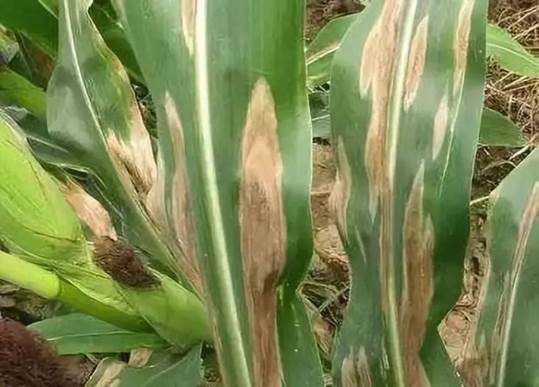

Disease cycle
The disease firstly occurs in the ground side of stem around the rainy season and progresses up through sheaths. Generally, it begins at jointing stage, develops rapidly at tasseling stage, and suffers severe damage at silking and filling stage. Continuous cropping, more water and fertilizer, high density, high humidity, poor ventilation and light transmission will cause severe disease. There is a lot of rain from July to August, which can easily induce diseases.
Control
(1) Strengthen cultivation management. Reasonable fertilization, avoiding excessive nitrogen fertilizer, reasonable irrigation and drainage, reducing field humidity and improving disease resistance. In the early stage of the disease, peeling off the infected leaf sheath in the ground side of stem can alleviate the disease.
(2) Chemical control. In the early stage of the disease, jinggangmycin 5% 100-150ml, jinggangmycin 20% SP 25g, or thifluzamide 240g/L 2000-3000 times were sprayed per mu.
2.4 Corn Smut
Symptoms
Smut is a local infection disease. It can occur in the whole growth period of corn. Fungal disease that causes malformation of plant body. White-surfaced galls (hypretrophy tissue) filled with black powder (smut spore) are formed in the leaves, nodes, sheath, and ears from the end of the rainy season. The galls on leaves and sheaths are usually small, with a diameter of only 1-2 cm or less, and generally do not produce black powder. The galls on the stem nodes and ears are larger, up to 15 cm in diameter. One plant of corn can produce multiple galls. Cystic or horn-shaped nodules often appear in the damaged parts of tassels. Female ears are mostly damaged in the upper half. Only a few small flowers produce galls, and the others can still bear fruit; the damage of whole ears can become a large gall.
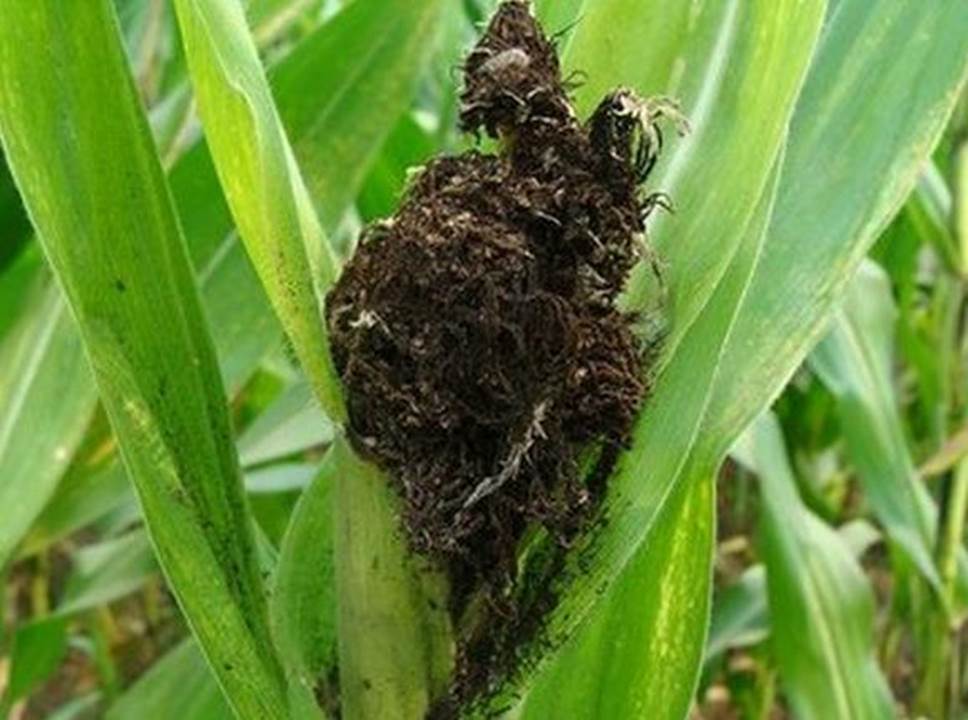
Disease cycle
Fungi overwinter as chlamydospores on the soil and diseased residues. When the spring conditions are suitable, they germinate to produce basidiospores, which spread with air currents and infect plants. The suitable temperature for spore germination is 26-30℃. If the density is too high and the nitrogen fertilizer is too much, the wound is conducive to the invasion of fungus. When the humidity is high, the disease is serious.
Control
(1) Eliminate fungal sources. After the corn is harvested, do not stack the straw in the field, when composting, it needs to be decomposed,and the disease residue in the field should be eliminated in time to reduce the fungus source of overwintering.
(2) Improve cultivation techniques. Implement crop rotation, strengthen field management, and timely control corn borer to enhance plant disease resistance. In addition, the galls should be removed and destroyed in time before it matures and ruptures.
3. Flowering to maturity stage
3.1 Corn Stalk Rot
Symptoms
The high incidence period is from milk ripening to waxing ripening period. Generally, it gradually expands upward from the lower leaves, showing a withered shape. Some diseased plants show acute symptoms after the rain, and the whole plant withers rapidly. The diseased stems become soft at the base, loose inside, and easy to fold in case of wind. After stem dissection, the pith was loose, and red lesions could be seen at the root and stem base.
Disease cycle
The residues of diseased plants, soil and seeds are the primary infection sources. Residues of diseased plants, soil and seeds are the primary infection sources. Overwintering fungi invade from roots after sowing to tasseling and silking stage, and spread in plants. Climatic conditions from grain filling to maturity, especially rainfall, are closely related to the disease. High temperature and humidity are prone to the disease.
Control
(1) Strengthen cultivation management, select disease-resistant inbred lines, reasonable fertilization and dense planting to enhance the disease resistance of corn.
(2) Rotation. Deeply plow the soil to remove the residues of diseased plants, and use the straw after full fermentation to reduce the fungal sources in the soil.
3.2 Corn Dry Rot
Symptoms
Severe disease mainly in the later stage of corn growth. Harm stems and ears. The base of the stalk and the ears produce large brown, black-brown, and purple-red lesions. In severe cases, the stalk is broken from the lesion. The cobs of the infected ears become loose and easy to break. The grains at the lower part of the diseased ear are brown and dull, and white mycelium is often found among the grains. The diseased ear adheres to the bract leaves and is not easy to peel off.
Disease cycle
The disease overwinters on diseased plant residues and seeds in the form of hyphae and conidia. Conidia are produced during the growing season and spread by air currents. High temperature and rain are conducive to pathogen infection and onset. Seed-carrying fungus is the main route of long-distance transmission. After sowing, when there is a lot of precipitation, high soil humidity, low temperature and seedlings grow weak, it is prone to disease.
Control
(1) Agricultural measures. Select disease-resistant varieties. Carry out 2-3 years of crop rotation, deep plow the soil in autumn, remove the diseased and disabled tissues in the field, and reduce the source of infection. Strengthen cultivation management, sowing in a timely manner, increase organic fertilizers, cultivate strong seedlings, and improve disease resistance.
(2) Chemical control. Soak the seeds with 50% carbendazim WP 1000 times solution for 24 hours, then rinse with water to sow. Spray carbendazim 50% WP or thiophanate methyl 50% WP 1000 times at the heading stage. Focus on spraying the ears and lower stems and leaves, and spray again after 7 days.
4. Main Pest Control
The ground pests of corn include corn borer, armyworm, cotton bollworm, aphids, corn spider mites, etc.
4.1 Corn borer: The main pests of corn (Lepidoptera: Pyralidae), it damages all parts of the ground of corn plants, generally occurs 2-4 generations a year, high temperature, low altitude, and more generations. Adults are active at night, have strong flying ability, have phototaxis, and have a life span of 5-10 days. They lay eggs on both sides of the midrib of corn leaves that are more than 50 cm above the ground and grow more luxuriantly. After hatching, the larvae gather together at first, then crawl and feed on the young part of the plant. The newly hatched larvae can spin and droop, and spread by falling to neighboring plants by wind.
4.2 Armyworm: It belongs to the Lepidoptera Noctuidae, and is the main pest of food crops and pasture crops, which seriously damages corn. Armyworm is a polyphagous, migratory and fulminant pest. Its occurrence is closely related to temperature and humidity. Generally, the optimum temperature for adults laying eggs is 19-25℃, and the temperature above 30℃ will be affected. In addition, the higher the humidity, the more conducive it is for adults to lay eggs, especially in a climate of alternating rain and high humidity, which is not only favorable for adults to lay eggs, but also conducive to the hatching of eggs and the survival and development of larvae.
4.3 Cotton bollworm: Lepidoptera, Noctuidae.
The above pests can be controlled with compounds such as lambda-cyhalothrin, chlorbenzuron, indoxacarb, and chlorfenapyr.
4.4 Corn leaf aphid: Damage to many gramineous crops and weeds. Clusters in the heart leaves at seedling stage, damage the ears after earing, suck juice, hinder the growth of corn, and can spread a variety of gramineous cereal viruses. When tassels and silks are covered with honeydew, the pollination process may be disrupted. In addition, it can spread corn dwarf mosaic virus disease, resulting in varying degrees of yield reduction.
It can be controlled with compounds such as imidacloprid, acetamiprid and thiamethoxam.
4.5 Corn spider mite: Damage to many crops. Adults and nymphs suck the sap of the back tissue of the host leaves, and the damaged leaves turn from yellow to white and then die, which affects the filling process of corn, resulting in a decrease in 1000-grain weight and a decrease in yield.
Generally, the occurrence probability of this pest is low, and avermectin can be used for control in severe cases.

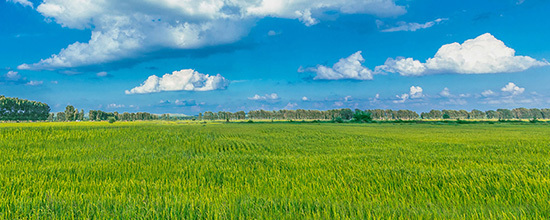
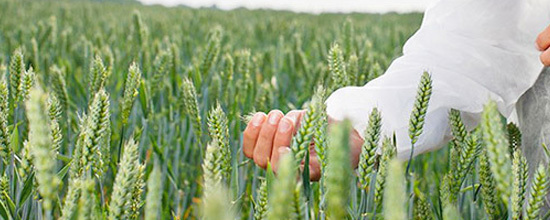


 LANGUAGE
LANGUAGE